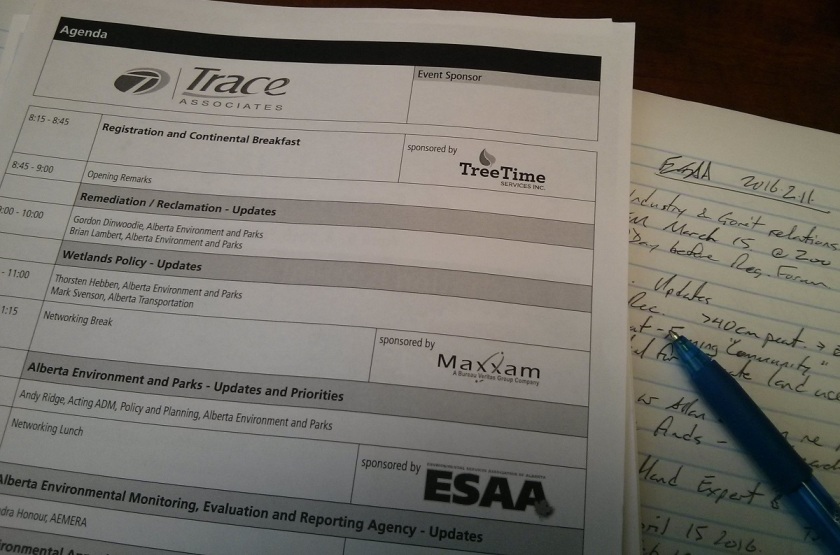
- Tree Time Services is proud to sponsor the breakfasts at the 2016 Edmonton and Calgary ESAA Regulatory Forums.
I attended the Environmental Services Association of Alberta regulatory forum in Edmonton on January 11th, 2016 with Mike Toffan, our Reclamation Coordinator. None of the regulatory updates dealt directly with Historical Resources Act concerns, but our work often occurs in the broader environmental regulation context, so it’s good to have a general understanding of things like the Environmental Protection and Enhancement Act and the Environmental Site Assessment Standards. The presentations by Gordon Dinwoodie and Brian Lambert of Alberta Environment and Parks were of particular interest to me. Throughout Brian Lambert’s overview of the updated standards on Environmental Site Assessment (ESA), I was struck by the parallels between Environmental Site Assessment and Historical Resources Impact Assessment (HRIA).
Both types of assessment deal with identifying a value on the landscape and coming up with a plan for how we’re going to manage that value. In an ESA, the value of concern is a negative one left at the end of project’s lifecycle, for example chemical contaminants in the soils and sediments. In the case of an HRIA, we’re dealing with the identification of a positive value on the land; historic, archaeological or palaeontological resources, and how we’re going to manage impacts to them in advance of a planned development.
In both cases, we have to first determine what, if anything, is there. We do this through a combination of historical research, remote sensing, and judgemental or systematic subsurface sampling. If we identify a conflicting value in the landscape, our next challenge is to delineate and evaluate it. We have to determine the spatial extent of the contaminant or the historic resource, both horizontally and vertically. The methods we use are again very similar: subsurface sampling by means of test holes, cores, backhoe trenches, etc. Even the semi-systematic test patterns we use are similar. We then evaluate the concern, using a combination of metric and qualitative measures, to determine what, if any, mitigation is required.
Mitigative strategies are similar too. We can mitigate impacts (to the environment or to the historical record) by removing and recovering the value in question, or we can try to manage the value in-place. Long-term management poses very similar challenges. Whether we’re talking about “Exposure Control” for environmental contaminants, or a long-term avoidance plan for a historic resource site within a project area, there are a lot of risks. Alberta Environment’s Site Assessment Standards lay out guidelines for an “Exposure Control” Risk Management Plan. The challenges to long-term management that they identify include:
- Containment to prevent migration
- Monitoring
- Ongoing communication to stakeholders
- Contingency planning for a containment failure
- A long-term commitment to future management of the concern
These are all concerns that are paralleled when we’re dealing with an industry commitment to manage a historic resource site. A key point to keep in mind is that under these Standards, there’s no “regulatory closure” for risk-managed (as opposed to mitigated) contaminated sites. This is a major problem in efforts at risk management for historic resource sites to date.
Throughout Lambert’s presentation, I kept thinking that the processes outlined in the new Environmental Site Assessment standards could provide a great framework for a scientific risk-management system for historic resources in the 21st century. I look forward to reviewing them in detail and seeing what I might be able to borrow from them to improve our historic resource management programs for our long-term clients.
To keep up to date on Historic Resource regulations and processes, you can subscribe to our quarterly Regulatory Update email.

One thought on “How are Historic Resources like Environmental Contaminants?”